 Palo Alto Stanford Heritage
Palo Alto Stanford Heritage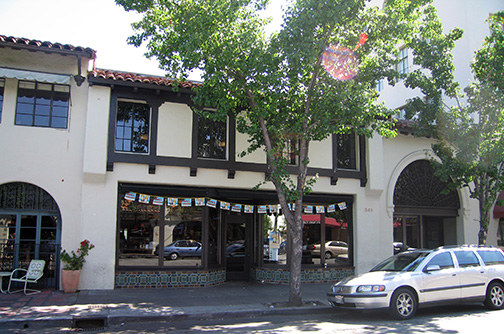 541 Ramona Street |
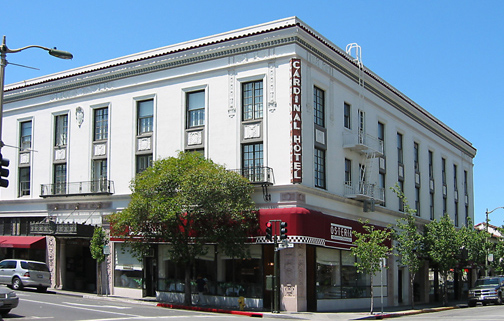 Cardinal Hotel - Willilam Weeks |
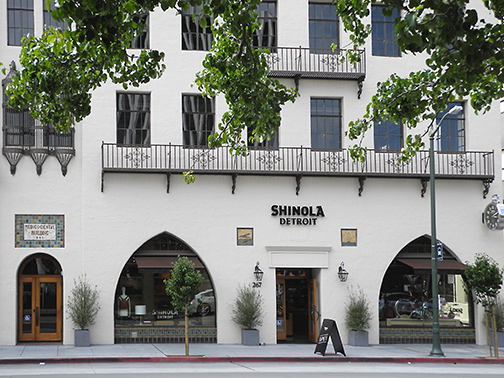 Renovated Birge Clark Medico-Dental Building |
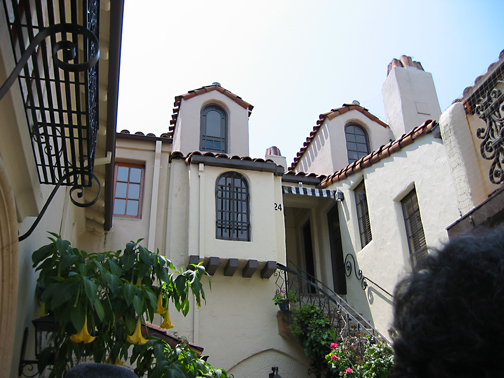 548 Ramona Street - Pedro de Lemos |
The following is from the National Register of Historic Places Inventory—Nomination Form dated May 21, 1985:
The Ramona Street Architectural District is located just south of the main downtown commercial street, University Avenue. the buildings are all in good to excellent condition. the 1920s Period Revival buildings draw heavily on Hispanic imagery and complement one another and together impart a unique character to the street. the syncopated rhythm of the streetscape is achieved by repetitive motifs of roof-lines, balconies, arches, and recesses. The eight buildings form a cohesive area of special architectural character, planned and developed in the period 1924–1938; subsequent alterations are minimal.
The buildings' heights range from one to four stories and are of the Monterey Colonial and Spanish Colonial Revival style, except the Cardinal Hotel, which has Classic elements. All the buildings, except the hotel, are characterized by stucco walls in muted colors and Spanish tile roofs of varying heights. Arches, balconies, wrought iron, and decorative glazed tiles are used throughout the district. Craftsman style woodworking details are present in both exteriors and interiors of several buildings in such elements as staircases and hand-adzed beam work.
Building plans were executed by designer Pedro de Lemos and architects Birge Clark and William H. Weeks. While many of the buildings were designed for an owner's specific use (i.e., dress shop, savings and loan, housewares, professional offices, hotel), some were commissioned by the Palo Alto Improvement Company.
The block is well recognized, and the two contributions of de Lemos are typically cited. A Guide to Architecture in San Francisco and Northern California (Revised 1976) by David Gebhardt et al. contains a separate entry for this block in p. 155 referring to this area as "A fine bit of commercial stage setting in the then-approved Spanish Colonial Revival Style . . . impressive for Northern California."
This application comes at a time when the City of Palo Alto is preparing both a new zoning ordinance for this downtown area, which will limit new growth and pressure property owners to maximize the allowable floor area ratio, and a seismic ordinance which could sunset non-conforming buildings. State and, eventually, national listings will aid preservation efforts.
Note: All buildings in the district are classified as contributing structures.
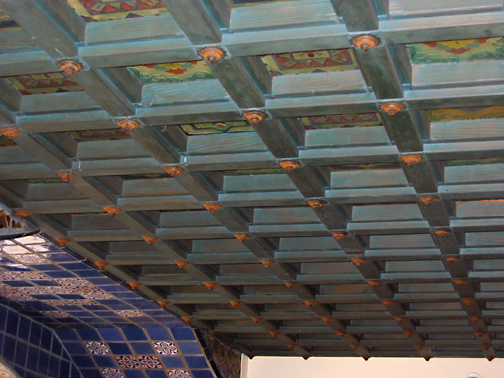 |
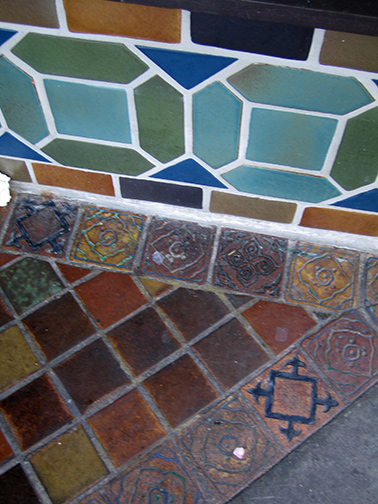 |
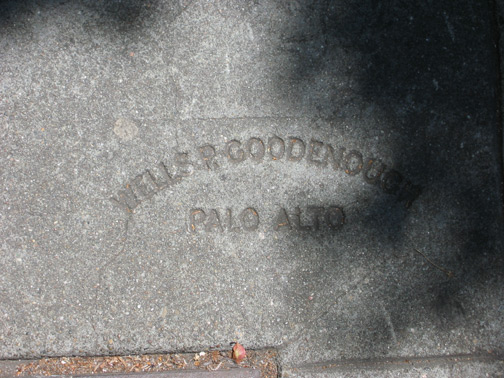 sidewalk stamp |
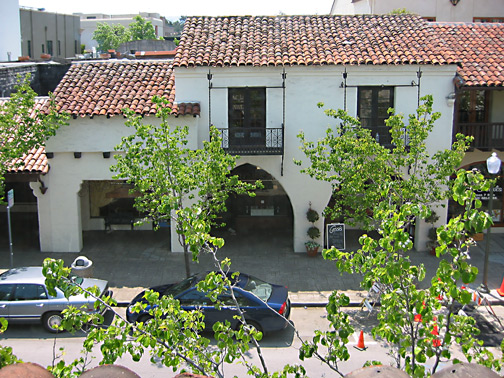 |
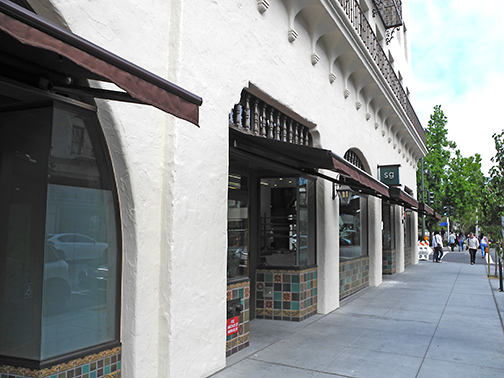 |
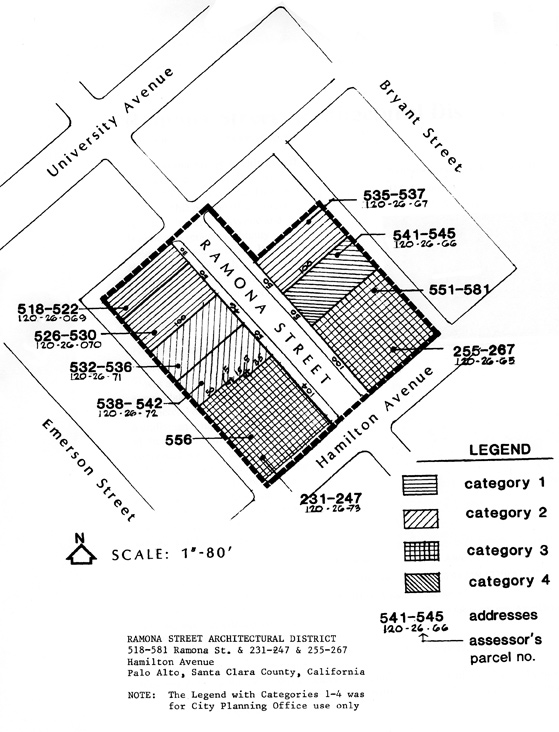 Enlarge |
The significance of the Ramona Street Architectural District is that is represents an architecturally unified area of buildings which were built during a particular period (1924-1938). The buildings in the district remain largely unaltered, and the architectural district contains no intrusions. The total absence of intrusions in a district characterized by a single predominant architectural style makes this area quite unique. Not only are the individual structures attractive in their own right, their relationship with one another established the character of the street. The architecture of this street is reminiscent of an architecturally untutored Spanish village.
Excellent examples of Monterey Colonial, Spanish Colonial Revival, and to a lesser extent, Craftsman Style architecture, line both sides of the tree-lined street. Although contemporary, Cardinal Hotel with its modified Neo-Classical elements is the one exception in the district that does not fall neatly into these other two categories. Nonetheless, the building is included in the district for two reasons. First, the structure is an important urban design element as it balances the four-story Medico-Dental building on the opposite corner. Second, the Cardinal Hotel, which is finished with many of the materials identical to those of the other buildings in the district, complements these other structures and reinforces the visual character of the street. These taller structures at the corner of Ramona Street and Hamilton Avenue complete the form of the street which is other wise composed of one- to three-story structures.
A simple palette of materials, carefully executed details, comfortable massing, and inviting plans with interior courts of the various buildings give this area its friendly human-scale quality. Thick stucco walls with recessed openings, carved wood, wrought iron, ceramic tile, and tile roofing are composed in a variety of forms which gives diversity to this visually unified area. the relatively few alterations done to the buildings over the years have been sensitively handled and in no way detract from their original character.
The regionally prominent designer Pedro de Lemos and architects Birge M. Clark and William H. Weeks designed the structures. Some of de Lemos' more notable works outside this district include the Allied Arts Guild in Menlo Park and his home in Palo Alto, "Waverley Oaks". Clark's more significant buildings of the era include the Dunker residence, the United States Post Office on Hamilton Avenue, and the Lou Henry Hoover house at Stanford (all listed on the National Register). the Palo Alto Community Center, the Kathleen Norris residence, and the Lucie Stern house. Weeks' architectural realizations are more common in Monterey county, although he designed several buildings in the Bay Area. The Masonic Hall on University Avenue in Palo Alto is one of his other local works. He was the architect of the Milias Hotel in Gilroy and, on the basis of that structure, presumably was commissioned to design the Cardinal Hotel.
The development of Ramona Street was an early successful attempt to expand laterally the central commercial district. De Lemos, a craftsman, graphic artist, and curator of the Stanford Museum, had been concerned with the larger scale, somewhat impersonal linear development along University venue. he felt that an informal architecture full of whimsy and integrated with nature was indeed compatible with commercial businesses. He, his family, and friends personally crafted many of his designs. The apparent smaller scale buildings designed by de Lemos (and later, Clark) adopted the then popular Spanish colonial Revival architectural style. The four-story Medico-Dental building at the corner of Ramona Street and Hamilton Avenue reflects Clark's sensitivity to the human scale character of the street. the street level tenant spaces of this structure which, incidentally, was Palo Alto's first building to have below-grade parking, contain Gothic elliptical and corbeled arches all on the same façade. The attempt to grant a tenant his own identity through stylized differences was indeed successful and adds to the small scale ambiance of this architectural district.
The district has been identified as architecturally significant in the local historical and architectural survey; it has also been adopted by the City of Palo Alto as a landmark district. The 500 block of Ramona Street has been identified by David Gebhardt, et al. in A Guide to Architecture in San Francisco and Northern California and has been recorded by the Historic American Buildings Survey.
E-mail us at either webmaster@pastheritage.org or president@pastheritage.org.
![]() Palo Alto Stanford Heritage—Dedicated to the preservation of Palo Alto's historic buildings.
Palo Alto Stanford Heritage—Dedicated to the preservation of Palo Alto's historic buildings.
Copyright © 2016 Palo Alto Stanford Heritage. All rights reserved.